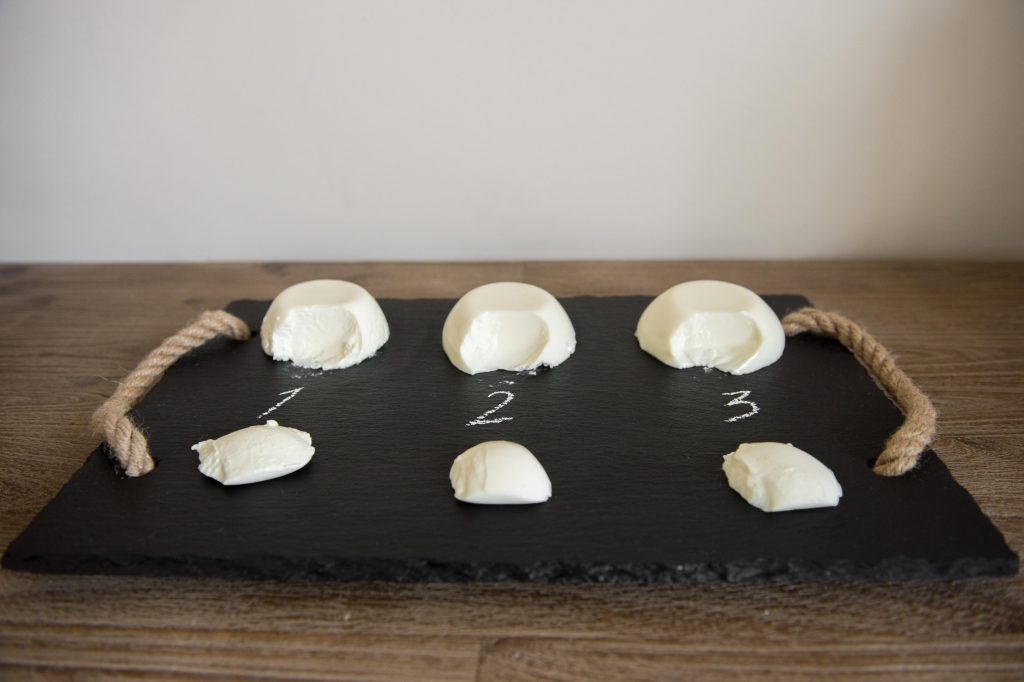06 May The Wobble Experiment
I like to do a little research before I try a new recipe. And by a little I mean a lot. After hours of searching through cookbooks, magazines, the internet (and specifically Pinterest), I narrow it down to two or three recipes and then play around until I’m satisfied it’s perfect. Maybe it’s the scientist in me, maybe it’s the perfectionist.
For a dessert as simple as panna cotta with only 4 main ingredients, there is actually quite a lot to play around with! The exact quantity of every one of these ingredients is crucial to getting the perfect result. In my pursuit for the perfect wobble, I expected the amount of gelatine to be the trickiest bit to figure out, but the ratio of milk to cream is in fact equally important.
I set up 3 basic recipes with varying ratios of milk and cream, keeping the method and all other ingredients identical. Recipe 1 used only cream, recipe 2 used two thirds cream and one third milk, and lastly recipe 3 used half cream, half milk (for full recipes and method scroll to the end).
My motto in life is generally “the more cream, the better” so I must admit the results were not what I expected!
*For the ultimate Panna cotta dessert recipe click here.
Recipe 1 (cream only):
The panna cotta was very firm, solid and dense, with hardly any wobble at all.
It was also sticky and hard to remove from the mould. The mouthfeel was quite buttery and very rich.
Recipe 2 (two thirds cream, one third milk):
A much better wobble here, and the panna cotta came cleanly out of the mould. The mouthfeel was lighter than Recipe 1 but still quite rich.
Recipe 3 (half cream, half milk):
It was very easy to remove the panna cotta from the mould, and what a beautiful wobble! A perfect melt-in-the-mouth texture, creamy but not too heavy or rich. WINNER!
Recipe 1:
500ml cream
70ml sugar
5ml vanilla extract
10ml powdered gelatine
30ml water
Recipe 2:
330ml cream
170ml full cream milk
70ml sugar
5ml vanilla extract
10ml powdered gelatine
30ml water
Recipe 3:
250ml cream
250ml full cream milk
70ml sugar
5ml vanilla extract
10ml powdered gelatine
30ml water
Directions:
- Sprinkle the gelatine over the water and allow to sponge for 5 minutes.
- Heat the cream, (milk) and sugar on low heat until it just comes to the boil, then remove from heat and add the sponged gelatine. Mix well until completely dissolved.
- Stir in the vanilla extract.
- Strain into a measuring jug and cover with clingfilm. Push it directly on the liquid (no air in-between).
- Pour into jars or moulds and refrigerate for 3 hours.



Oriol
Posted at 07:50h, 13 JulyHi, Astrid.
I arrived to blissfullydomestic.me through a comment you left to my rice pudding photo on instagram. Thank you for the comment! I’m glad you left it, because i got to visit your blog and I love it.
I especially enjoyed reading this post because, although I probably do not have a “cientific mind” as you have, I love doing this kind of experiments (and I am a perfectionist) as well.
I prepared panna cotta myself a few days ago. I was tired of trying to find the perfect ratio of ingredients, so I substituted egg whites for the gelatine and used another procecure (water bath). The result probably ressembles that of your first recipe: it is dense and rich. But I confess I love it not that wobbly.
I’ll continue reading your “science bite” section, now!
Bye,
Oriol
Astrid
Posted at 16:09h, 31 JulyHi Oriol
Thanks so much for your comment. I really love testing out recipes and experimenting with ingredients. Very interesting about the egg whites – what a fab idea! Keep in touch 🙂
Rosemarie
Posted at 16:27h, 21 OctoberHi Astrid. You mention gelatine in ml.How do you measure this? Would 10ml of gelatine be the same as 10g?
Astrid
Posted at 15:00h, 31 OctoberHi Rosemarie. I used the powdered gelatine and measured in teaspoons. The equivalent weight in grams would be 6g.